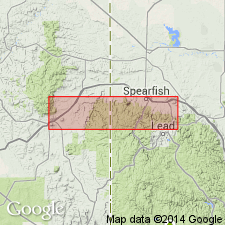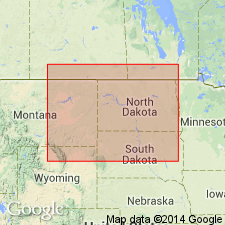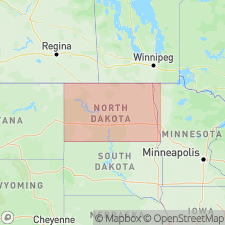
- Usage in publication:
-
- Aladdin sandstone
- Modifications:
-
- Original reference
- Dominant lithology:
-
- Sandstone
- AAPG geologic province:
-
- Powder River basin
- Williston basin
Summary:
Pg. 45 (chart), 46-47; M.R. McCoy, 1958, Wyoming Geol. Assoc. Field Conf. Gdbk., no. 13, p. 25-30. Aladdin sandstone. Brownish, cross-bedded, fine- to medium-grained, quartzose-type sandstone which is occasionally calcareous. Commonly 12 to 25 feet thick. Underlies Ice Box [Icebox] shale (new); Overlies Deadwood formation. Recognized in eastern Wyoming and western South Dakota. =SKOLITHOS (SCOLITHUS) sandstone [of Furnish and others, 1936]. Correlative with St. Peter sandstone of Wisconsin and Iowa and lower part of Winnipeg formation of Williston basin. Age is considered Middle Ordovician (Chazyan).
Type section: on southern flank of Sheep Mountain, in sec. 14, T. 52 N., R. 63 W., Bear Lodge Mountains, Crook Co., eastern WY. Named from nearby town of Aladdin, eastern WY.
[Typographical error (US geologic names lexicon, USGS Bull. 1200, p. 35): thickness of Aladdin commonly 12 to 25 feet, not 25 to 30 feet (=Roughlock siltstone thickness).]
Source: Publication; US geologic names lexicon (USGS Bull. 1200, p. 35).

- Usage in publication:
-
- SCOLITHUS sandstone*
- Aladdin sandstone of McCoy (1952)*
- Modifications:
-
- Areal extent
- AAPG geologic province:
-
- Powder River basin
- Williston basin
Summary:
Pg. 442-444. Aladdin sandstone of McCoy (1952); SCOLITHUS [SKOLITHOS] sandstone of this report.
"In 1952 McCoy (p. 44-47) proposed names for the siltstones, shales, and sandstones which lie beneath the true dolomites of the Whitewood and above the Deadwood formation in the northern Black Hills. These in descending order are the Roughlock siltstone, the Ice Box [Icebox] shale, and the Aladdin sandstone --the last being the Scolithus sandstone of authors. Unfortunately McCoy's account was written for a guidebook and is necessarily abbreviated. Until a more complete treatment of these units is published, it will not be possible to determine their utility. McCoy has noted that his units change facies within short distances; some of these lithic changes have been verified and others found during the present reconnaissance. It is evident that more work needs to be done before his nomenclature can be evaluated or consistently applied even in the Black Hills.
Obviously a large portion, if not all, of the interval between the Whitewood and Deadwood strata is equivalent to the Winnipeg formation in position, in lithologic character, and probably in faunal content, but published and otherwise available information is far too sketchy to permit interchangeability of terminology at this juncture. As an example, several geologists feel that the so-called Scolithus (or Aladdin of McCoy, 1952) sandstone is the same as the basal sandstone of the Winnipeg formation; actually we know only that earliest Early Ordovician fossils have been obtained just below this sandstone in the uppermost Deadwood strata (Lochman and Duncan, 1950, p. 351; McCoy, 1952, p. 47) and that Middle Ordovician(?) shale overlies it in the northern Black Hills. In the Carter Oil Co. Northern Pacific No. 1 well to the north, [correlations are inconclusive]." "It may later prove possible to trace the Roughlock, Ice Box, and Aladdin formations as proposed by McCoy beneath the surface in wells located close to the flanks of the Black Hills, but it would be inadvisable to use his terminology in the area of this report."
Source: Publication.

- Usage in publication:
-
- Aladdin sandstone
- Modifications:
-
- Not used
- AAPG geologic province:
-
- Williston basin
Summary:
Pg. 9 (fig. 2), 10-11, 49; C.G. Carlson, 1958 (1959), Stratigraphy of Deadwood-Winnipeg interval in North Dakota and northwestern South Dakota, 2nd Intl. Williston Basin Symp., p. 20-26. Author includes the SKOLITHOS (SCOLITHUS)-bearing sandstone (=Aladdin sandstone of McCoy, 1952, unit B of Whitewood formation of Butler and others, 1955) at top of Deadwood formation.
[See also R.J. Ross, Jr., 1957, USGS Bull. 1021-M, p. 443, 444.]
Source: Publication.
For more information, please contact Nancy Stamm, Geologic Names Committee Secretary.
Asterisk (*) indicates published by U.S. Geological Survey authors.
"No current usage" (†) implies that a name has been abandoned or has fallen into disuse. Former usage and, if known, replacement name given in parentheses ( ).
Slash (/) indicates name conflicts with nomenclatural guidelines (CSN, 1933; ACSN, 1961, 1970; NACSN, 1983, 2005, 2021). May be explained within brackets ([ ]).

